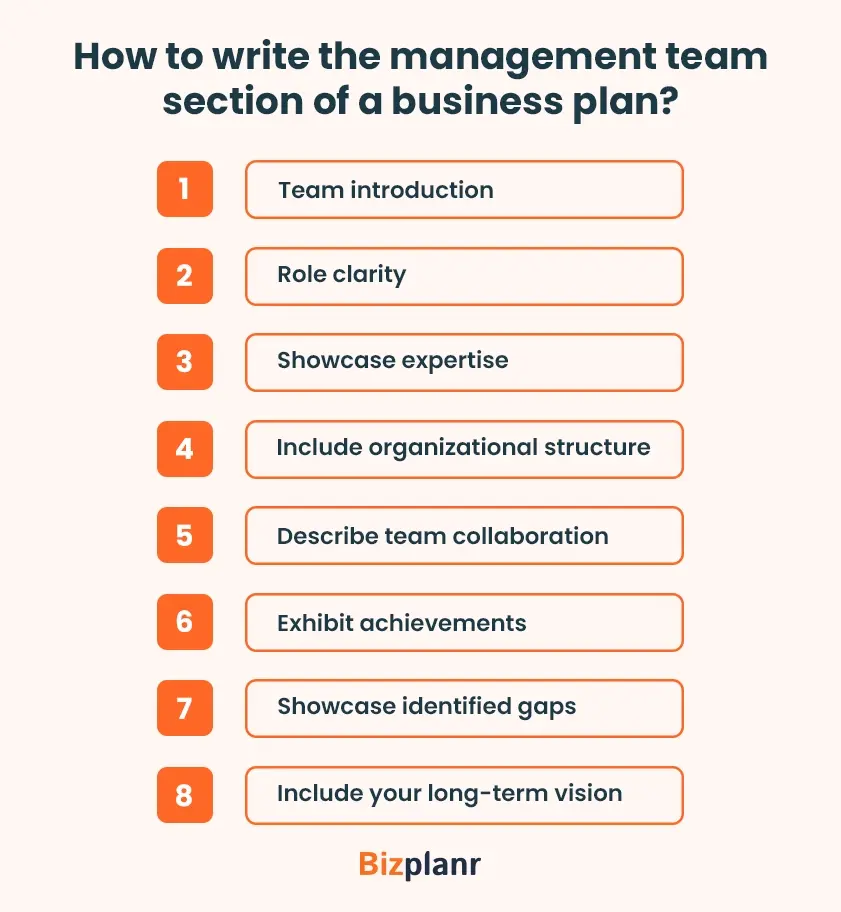Building and aligning a solid management team is crucial for every business’s success.
Steve Jobs once said, "Great things in business are never done by one person; they're done by a team of people."
Therefore, to succeed in your business, you must plan it with a strong focus on your management team.
A strong management team not only contributes to your business success but helps you secure funding from investors and communicate clear intentions to stakeholders regarding your goals.
But what exactly is the management team in a business plan? What is its importance? How do you write a management team in a business plan? Well, you will get all the answers in this blog.
Let’s get started.
What is a management team in a business plan?
Management team in a business plan is a section that outlines the main responsibilities of operational teams, key managers, and employees for leading the company toward its desired goals.
The purpose of including the management team in a business plan is to:
- Identify management team gaps
- Highlight management team members
- Showcase the relevant experience and expertise of each member
- Demonstrate how the team’s skills align with the company’s objectives
- Illustrate the team's ability to adapt to challenges and seize opportunities
Moreover, this management section, highlighting the management team, builds confidence in potential investors and stakeholders by showcasing the company's ability to execute its strategies and succeed.
Why is the management team section important for a business plan?
A well-defined management team provides a solid foundation for effective decision-making and strategic guidance that helps your business to achieve its desired goal.
Here are some more reasons that make a management section crucial in a business plan:
Cultivates investor confidence
69% of venture capitalists say they won't invest in a new business without first reviewing its business plan.
This means investors don’t just focus on your idea—they want to know if your team can successfully execute the plan.
A capable management team assures them that the business can navigate challenges and seize opportunities efficiently. Such confidence boosts their trust in your business, making it more likely that they will invest.
Streamlines strategy execution
A management team with skilled and experienced executives paves the way to your goals more smoothly.
Their expertise enables them to execute your business strategy effectively, helping you achieve your desired outcomes efficiently.
Additionally, their knowledge and experience equip your business to handle challenges that arise during strategy execution. They also can turn setbacks into opportunities.
Provides clear direction
A well-defined management team provides clear leadership and direction. This clarity ensures that everyone in the organization understands their roles and goals.
A clear and right direction benefits your business by:
- Enabling easy execution of business plans
- Offering a clear understanding of the business structure and key members
- Improving team alignment towards common objectives
- Enhancing decision-making processes across the organization
- Streamlining communication between departments
- Promoting accountability and ownership within the team
Manages risk efficiently
Business plans are designed to minimize risks and ensure smooth operations. Including a management team in your business plan can help reduce your business's risks.
An experienced team can spot potential challenges and create strategies to overcome them. Importantly, the management team is also valuable in predicting upcoming risks, which helps your business prepare to tackle them effectively.
Foster team cohesion
A successful business thrives on collaboration and unity. When your team is aligned and working towards the same goals, it increases the chances of achieving success more quickly.
That’s why Helen Keller famously said, “Alone, we can do so little; together, we can do so much.” By including the management team section in the business plan, you foster team cohesion, which ultimately benefits your business with:
- More productivity
- Enhance collaboration
- Quick solution to challenges
- Right execution of the business plan
How to write the management team section of a business plan?
To write a management team section in a business plan, go through the following step-by-step process:
Step 1: Team introduction
Start by introducing your internal management team and key players who will lead your business. Include the names of the core team members, such as board members, managers, HRs, sales head, and department heads.
Provide a brief overview of their background, showcasing their qualifications and areas of expertise that will support the company’s goals. Moreover, you should also include following aspects in the introduction section:
- Name and position
- Job description
- Brief background and relevant experience
Step 2: Role clarity
Define the specific roles and responsibilities of each management team member. Doing so ensures that stakeholders understand who is responsible for which areas of the business.
Further, the clear role of each member defines how they contribute to the company's objectives and work towards achieving business objectives. Make sure you include the following aspects in your role clarity section:
- Job titles
- Specific responsibilities
- Key contributions to business objectives
Step 3: Showcase expertise
Highlight the experience, qualifications, and key achievements of each management team member. This demonstrates the capability of your team and how their skills align with the business strategy.
Showcasing their experience and expertise demonstrates their capabilities to stakeholders, which strengthens their confidence in the team’s ability to drive growth and navigate challenges.
Here’s what you can add in the expertise section:
- Professional experience
- Relevant qualifications and skills
- Educational background
- Notable achievements
Step 4: Include organizational structure
Present your company’s hierarchy to illustrate how decisions are made and how each department functions.
Including an organizational chart helps readers understand the reporting structure and the flow of decision-making authority.
You can include:
- An organizational chart that provides overview of team
- Reporting structure
- Explanation of decision-making authority
Step 5: Describe team collaboration
Outline how the management team works together to achieve business goals. Highlight tools or platforms used for collaboration, communication methods, and the regularity of meetings.
This highlights the role of teamwork in the company’s success. Additionally, explaining team collaboration to stakeholders instills confidence that everyone is aligned and working towards common goals.
You should include:
- Which communication tools you’re using (e.g., Slack, Microsoft Teams)
- Collaboration methods
- Regular meetings or review processes
Step 6: Exhibit achievements
Highlight the major accomplishments of the management team. This includes awards, recognition, completed projects, or case studies that show your team’s ability to execute plans effectively.
Exhibiting achievements will ensure your team has experience working in the same field and has the capability of bringing results. You can include:
- Awards or recognitions
- Major projects or milestones
- Success stories
To demonstrate your achievement and impress your stakeholders.
Step 7: Showcase identified gaps
Include identified gaps in your management team section in a business plan and explain how you plan to address them. This shows foresight and preparedness, especially if you plan to hire new talent.
Demonstrate the following aspects to showcase your gaps:
- Missing roles or skills
- Plan to fill gaps (e.g., recruitment or external support)
- Timeline for addressing gaps
Step 8: Include your long-term vision
Outline how your management team will contribute to the long-term success and growth of the business. Discuss strategic goals and the role of the management team in achieving these milestones.
Here’s what you can include:
- Strategic goals
- Growth roadmap
- Role of the team in future success
The steps to write the management team section in a business plan concludes here. Remember, following these steps ensures you present a strong, well-structured team to stakeholders.
However, if you need help with including a company overview in a business plan, check out our blog that outlines effective ways to write a company overview in a business plan.
Example of a strong management team section in a business plan
Management Team of FreshServe—Food Delivery App
FreshServe's management team combines experience, strong educational background, industry expertise, and leadership. Below is an overview of our internal and external teams.
Internal Management Team
1. CEO (Chief Executive Officer) – Sarah Mitchell
Responsibilities: Oversees overall company operations, sets strategic direction, and leads expansion efforts. Manages investor relations and drives key business partnerships.
Qualification: MBA, Harvard Business School
Experience: 15 years in tech startups, including leading a food tech startup that was successfully acquired.
Achievement: Expanded previous startup to 10 cities within 2 years, driving $100M in annual revenue.
2. COO (Chief Operating Officer) – David Lee
Responsibilities: Manages daily operations, logistics, and ensures the smooth execution of FreshServe's food delivery services. Oversees customer service and logistics teams.
Qualification: BS in Operations Management, University of California, Berkeley
Experience: 12 years in operations and logistics management in food delivery and e-commerce.
Achievement: Scaled logistics operations of a delivery company, achieving a 98% on-time delivery rate.
3. CMO (Chief Marketing Officer) – Laura Garcia
Responsibilities: Leads all marketing, branding, and customer acquisition efforts. Develops growth strategies, digital marketing campaigns, and partnerships with restaurants.
Qualification: BA in Marketing, Stanford University
Experience: 10 years in digital marketing, previously working with a major food delivery service.
Achievement: Increased user base of previous employer by 300% in 18 months through targeted digital campaigns.
4. CTO (Chief Technology Officer) – Raj Patel
Responsibilities: Oversees all technological development, including mobile app development, software updates, and security. Manages the tech team and ensures a seamless customer experience.
Qualification: MS in Computer Science, MIT
Experience: 14 years in software development and app creation, specializing in food tech and delivery systems.
Achievement: Led the development of an AI-powered logistics system that reduced delivery times by 25%.
5. CFO (Chief Financial Officer) – Lucas Daniels
Responsibilities: Responsible for managing company finances, including budgeting, forecasting, and financial planning. Oversees investor relations and capital raising efforts.
Qualification: MBA, CFA certification
Experience: 10+ years in financial management, particularly with high-growth tech startups.
Role in FreshServe: Will manage financial strategy and ensure financial sustainability as FreshServe expands. A CFO with experience in scaling tech-based companies is ideal for this role.
6. Product Manager – Emily Turner
Responsibilities: Leads the product development and innovation process for the FreshServe app. Ensures customer feedback is integrated into product updates and improvements.
Qualification: BS in Product Management, University of Michigan
Experience: 7 years in product management, particularly in tech startups.
Achievement: Launched two successful app updates that improved user retention by 40%.
Organization Structure
Here’s the breakdown of organizational structure of FreshServe, including its decision-making hierarchy:
1. Sarah Mitchell (CEO):
- Leads the company and oversees all the departments. Everyone in the organization ultimately reports to the CEO.
2. Raj Patel (CTO):
- Reports to Sarah Mitchell (CEO).
- Oversees technology and product development.
- Emily Turner (Product Manager) reports directly to Raj Patel.
3. David Lee (COO):
- Reports to Sarah Mitchell (CEO).
- Manages day-to-day operations and logistics.
- James Morris (Logistics Manager) reports directly to David Lee.
- Rachel Brown (Customer Service Representative) reports to James Morris.
4. Laura Garcia (CMO):
- Reports to Sarah Mitchell (CEO).
- Handles marketing and customer acquisition.
- John Anderson (Social Media Manager) reports directly to Laura Garcia.
5. Lucas Daniels (CFO):
- Reports to Sarah Mitchell (CEO).
- Manages financial planning, budgeting, and investor relations.
External Management Team (Advisory Board)
1. Jessica Adams – Legal Advisor
Responsibilities: Provides legal and strategic guidance on contracts, intellectual property, and regulatory compliance, ensuring FreshServe adheres to all legal standards.
Experience: 18 years in corporate law, specializing in tech startups and M&A.
2. Michael Carter – Financial Advisor
Responsibilities: Assists with financial planning, investment strategies, and capital raising efforts. Advises on budgeting, cash flow, and investor relations.
Experience: 20 years in finance, former CFO at MealFast.
3. Angela Wright – HR Consultant
Responsibilities: Guides on building the internal HR structure, hiring strategies, and employee retention programs. Ensures the company attracts and retains top talent.
Experience: 15 years in human resources management, specializing in tech startups.
Wrapping up
We've covered everything you need to know about the management team section of a business plan.
So, if you’re planning to write a business plan, include the key elements we've discussed in the blog to impress your stakeholders or investors and showcase your team effectively.
Remember, the management team is just a section of a business plan, and you need a complete business plan for success. You can rely on Bizplanr, an AI business plan generator to craft an excellent business plan.
By answering a few questions, you can design your business plan in minutes; from the management team to the conclusion, this platform will design the business plan that will provide tangible results.
Try today!
Get Your Business Plan Ready In Minutes
Answer a few questions, and AI will generate a detailed business plan.
Frequently Asked Questions
What should be included in the management team section?
Include team members’ names, roles, qualifications, experience, and achievements. Highlight their responsibilities and how they contribute to the business’s success.
How do you structure a management team?
Structure the team based on key roles such as CEO, CTO, COO, and department heads like marketing, sales, and finance. Each role should have clear responsibilities aligned with company goals.
What is the role of a management team?
The management team oversees the company's day-to-day operations, strategic planning, and execution to achieve business goals.
What is the company's management team profile?
It summarizes the key executives, their backgrounds, and how their skills and experience contribute to the company’s success.
What’s the difference between a management team and an advisory board?
The management team handles daily operations and strategy execution, while advisory board members offer external guidance and expertise but don't manage day-to-day tasks.
What if my business lacks experienced management?
Address this by hiring experienced consultants and advisors or seeking external partners. Emphasize the skills and potential of the existing team and outline plans for filling gaps.








